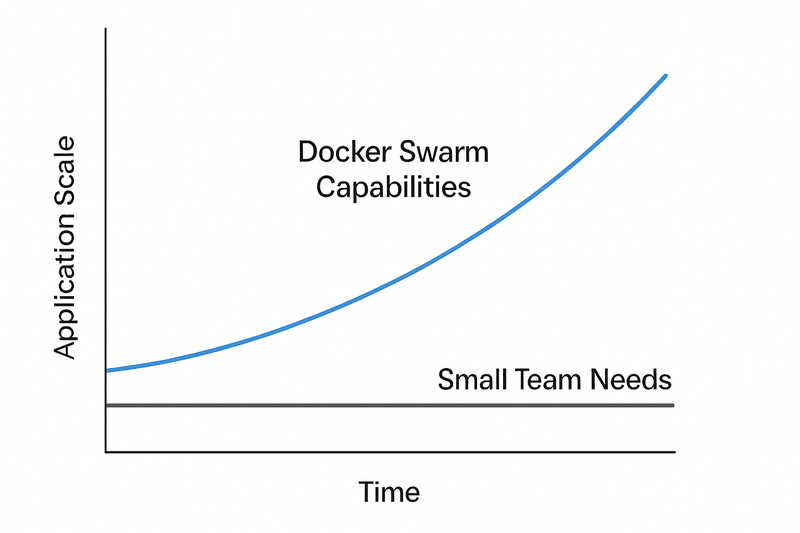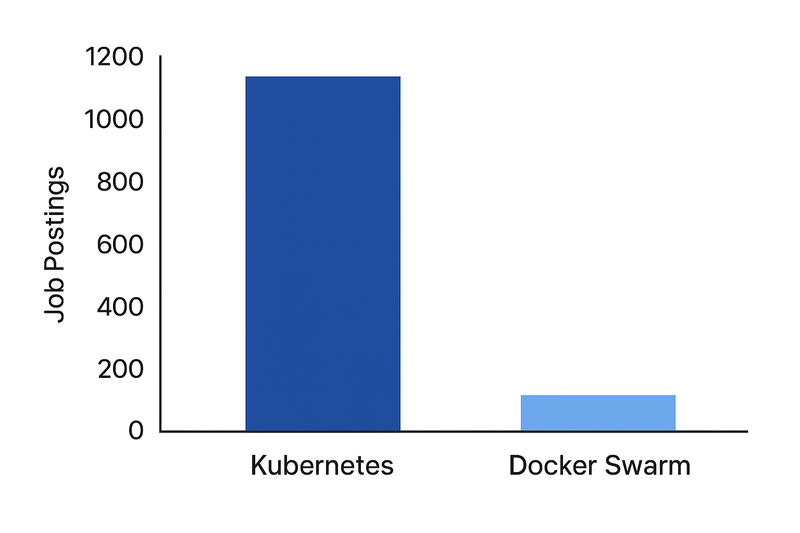Struggling to choose between Docker Swarm and Kubernetes for your small team? This comprehensive 2025 guide reveals why most small DevOps teams are over-engineering their container orchestration, with real-world examples, cost analysis, and a practical decision framework based on team size and actual needs rather than theoretical scaling requirements.
Technical Decision Disclaimer: The following content is for educational purposes and general guidance. Container orchestration choices can significantly impact your business operations, deployment reliability, and team productivity. Always consult with qualified DevOps engineers or technical architects who understand your specific requirements before making infrastructure decisions. Technology landscapes evolve rapidly, and this analysis reflects the state as of September 2025.
I've been thinking about this question a lot lately because I keep seeing small DevOps teams struggle with the same choice: Docker Swarm or Kubernetes? Most people just default to Kubernetes because that's what everyone talks about. But I think they're making a mistake.
Here's what I've noticed: the loudest voices in our industry come from big tech companies. They have 200 person engineering teams, dedicated platform engineers, and budgets for complexity. When they say "just use Kubernetes," they're solving a very different problem than a 5 person startup trying to ship their first product.
I've watched several small teams over the past few years, and there's a pattern. The ones that jumped straight to Kubernetes spent significantly more time learning the platform. The ones that started with Docker Swarm were deploying code much faster.

The Container Orchestration Reality Nobody Talks About
Most container orchestration comparisons focus on features. "Kubernetes has better networking." "Kubernetes has more plugins." But they miss the most important question for small teams: what's the cost of those features?
I don't mean money. I mean time, complexity, and cognitive load. Every feature you don't need is overhead. Every configuration option is a decision that slows you down.
Think about it this way: if you need to get across town, a Ferrari is objectively better than a Honda Civic. But if you're just learning to drive, the Ferrari might kill you.
Why Small Teams Choose the Wrong Orchestration Tool
The problem is that most container orchestration advice comes from enterprise contexts. Large organizations have different constraints than small DevOps teams. They need advanced networking, compliance features, and multi-cloud deployment capabilities. Small teams need to ship features quickly.
What Small DevOps Teams Actually Need from Container Orchestration
Here's what I've learned from talking to DevOps engineers at small companies. They need:
- Something that works tomorrow, not next quarter
- Predictable behavior with minimal configuration
- The ability to troubleshoot without reading 500 page documentation
- A solution that doesn't require a dedicated platform team
When I frame it this way, Docker Swarm starts to look pretty attractive for small teams.
Let me show you what I mean. To deploy a simple web app with Docker Swarm, you need relatively few lines of configuration using familiar Docker Compose syntax. With Kubernetes, you're looking at multiple YAML files, ConfigMaps, Services, Ingress controllers, and a bunch of other concepts that don't add immediate value for a simple use case.[^1]
Example of docker-compose.yml for Docker Swarm
Docker Swarm vs Kubernetes Learning Curve: The Productivity Impact
Actually, let me be more specific about the learning curve differences. Based on developer community reports, Docker Swarm setup typically takes hours to understand because it uses familiar Docker concepts and commands. Kubernetes setup and comprehension often requires days or weeks due to its complex architecture involving Pods, ReplicaSets, Deployments, and networking concepts.[^2] This pattern reflects the fundamental difference: Docker Swarm prioritizes simplicity and rapid deployment, while Kubernetes offers enterprise-grade features at the cost of complexity.
The Kubernetes Complexity Trap for Small Teams
There's this trap I see teams fall into. They choose Kubernetes because they plan to scale to 100 microservices eventually. But "eventually" never comes, or it comes much later than they think. Meanwhile, they've spent months learning a complex system instead of building their product.
I think this happens because we're optimizing for imaginary future problems instead of real current ones. It's like buying a server rack for your laptop because you might need a data center someday.
Docker Swarm Production Scalability: The 2025 Reality
The surprising thing is that Docker Swarm can handle more scale than most people think. According to Docker's official documentation, the platform supports scaling services to 50+ replicas, and production deployments continue to use Docker Swarm successfully in 2025 for small to medium-sized applications.[^3] Based on documented case studies, teams have successfully operated multiple applications on multi-node Swarm clusters for extended periods with minimal operational overhead.
By the time you outgrow Docker Swarm, you'll probably have learned enough about your actual production requirements to know whether Kubernetes is the right next step, or if you need something else entirely.

How Team Size Determines Your Container Orchestration Choice
Here's something interesting I've observed about team dynamics in many organizations:
Small Team Infrastructure Patterns (5-10 Engineers)
Everyone typically wears multiple hats. Your backend developer is also configuring deployments. Complex orchestration tools often slow everyone down. Docker Swarm excels here because developers can use familiar Docker commands to manage container orchestration.
Medium Team Structure (10-25 Engineers)
You start having some specialization, but probably not a full-time platform engineer. You can handle more complexity, but it's still a tax on productivity. This is where Kubernetes alternatives like HashiCorp Nomad or managed services might make sense.
Large Team Capabilities (25+ Engineers)
Now you can often afford someone whose job is to understand Kubernetes deeply. The complexity starts paying for itself. Enterprise features become valuable rather than overhead.
Most teams I talk to are in the first category, but they're choosing tools designed for the third category. That seems backwards to me.
A Decision Framework for Container Orchestration in 2025
After seeing this play out over and over, I think the decision comes down to a simple question: what's your constraint?
If Your Constraint is Time to Market
Choose Docker Swarm. You'll be productive immediately. The learning curve is gentle, and you can deploy applications within hours of setup.
If Your Constraint is Advanced Orchestration Features
Choose Kubernetes. But be honest about whether you actually need those features right now. Advanced networking, service mesh capabilities, and extensive ecosystem tools come at a significant learning cost.
If Your Constraint is Hiring and Team Growth
This gets interesting. Current job market data shows significantly more Kubernetes positions available with over 1,200 Kubernetes specific job postings tracked in Q1 2025 alone, compared to only 176 Docker Swarm related positions.[^4] Engineers want to learn Kubernetes for career growth. However, there are also fewer people who can set up Kubernetes environments effectively, so you might spend longer finding the right expertise.

Container Orchestration Migration: Something I'm Still Figuring Out
The one thing I'm not sure about is the migration path. If you start with Docker Swarm, how hard is it to move to Kubernetes later? I've seen a couple of teams do this successfully, and it wasn't as bad as expected. The hard work containerizing applications, thinking about service boundaries, handling configuration is the same either way. The orchestration layer is just swappable plumbing.
But I've also seen teams get so comfortable with Docker Swarm's simplicity that they never want to leave. That might be fine. Or it might create problems I haven't seen yet.
What I'd Choose for Small DevOps Teams in 2025
If I were starting a new project with a small team in 2025, here's what I'd do:
Start with Docker Swarm. Get your application deployed and learn the basics of container orchestration without the complexity tax. Build your product and find product market fit.
If you're successful and start hitting Swarm's limits, maybe you need advanced networking, or you want to run ML workloads, or you're hiring platform engineers who prefer Kubernetes then migrate. By then you'll understand your actual requirements instead of guessing. The key insight is that choosing technology is like choosing any other tool. You don't need the most powerful option, you need the right option for your current situation.
And for most small DevOps teams, that's Docker Swarm.
Next Steps for Your Small DevOps Team
If you're convinced Docker Swarm might be right for your small DevOps team, start simple:
- Try it with a non-critical service first, maybe a monitoring tool or internal dashboard
- Learn the basics of Docker Compose, Swarm uses similar syntax, so this knowledge transfers
- Set up a 3-node cluster for high availability (you can do this on approximately $18/month using DigitalOcean's basic droplets)[^5]
- Document your deployment process from day one, future you will thank you
And if you're already deep into Kubernetes but feeling overwhelmed, that's normal. You're not alone, and you're not failing. Complex tools have a learning curve. Just be honest about whether that complexity is serving your current needs or getting in the way.
Frequently Asked Questions About Docker Swarm vs Kubernetes
Do I Need Kubernetes for My Small Team?
Not necessarily. If you have fewer than 25 engineers and straightforward deployment needs, Docker Swarm often provides better productivity with lower operational overhead.
Is Docker Swarm Still Relevant in 2025?
Yes. Despite predictions of its demise, Docker Swarm is experiencing a renaissance in 2025 as teams rediscover that simple container orchestration solves their actual problems without introducing unnecessary complexity.
How Long Does It Take to Learn Docker Swarm vs Kubernetes?
Docker Swarm typically requires hours to days for teams familiar with Docker. Kubernetes often requires weeks to months to achieve productivity due to its complex architecture and extensive feature set.
What Team Size Is Right for Kubernetes?
Organizations with 25+ engineers often benefit from Kubernetes advanced features. Teams with dedicated platform engineers can absorb the complexity cost and leverage enterprise-grade capabilities.
When Should I Migrate from Docker Swarm to Kubernetes?
Consider migration when you need advanced networking, service mesh capabilities, extensive ecosystem integrations, or when your team has grown to support dedicated platform engineering roles.
What do you think? Are you using Kubernetes when Docker Swarm would have been enough? Or have you found that Kubernetes complexity pays for itself even on small teams? I'm curious about other people's experiences here.
References and Sources
[^1]: CircleCI Blog. "Docker Swarm vs Kubernetes: how to choose a container orchestration tool." https://circleci.com/blog/docker-swarm-vs-kubernetes/
[^2]: Multiple sources including Spacelift Blog and Last9 confirm the learning curve differences: Docker Swarm requires minimal learning curve for Docker-familiar teams, while Kubernetes has a "steep learning curve" requiring understanding of unique concepts like Pods, ReplicaSets, and Deployments.
[^3]: Docker Official Documentation. Swarm mode scaling capabilities. https://docs.docker.com/engine/swarm/ and community reports on Docker Swarm production viability in 2025.
[^4]: Kubernetes Career Report Q1 2025. "The state of Kubernetes jobs in 2025 Q1." https://kube.careers/state-of-kubernetes-jobs-2025-q1
[^5]: DigitalOcean pricing as of September 2025: Basic Droplets at $6/month each for a 3-node cluster configuration.
About Technical Recommendations: This analysis is based on publicly available information, community reports, and industry trends as of September 2025. Individual use cases may vary significantly. For mission critical deployments or complex enterprise requirements, consult with experienced DevOps professionals who can assess your specific technical and business needs. Container orchestration choices have long-term implications for scalability, maintainability, and team productivity.


